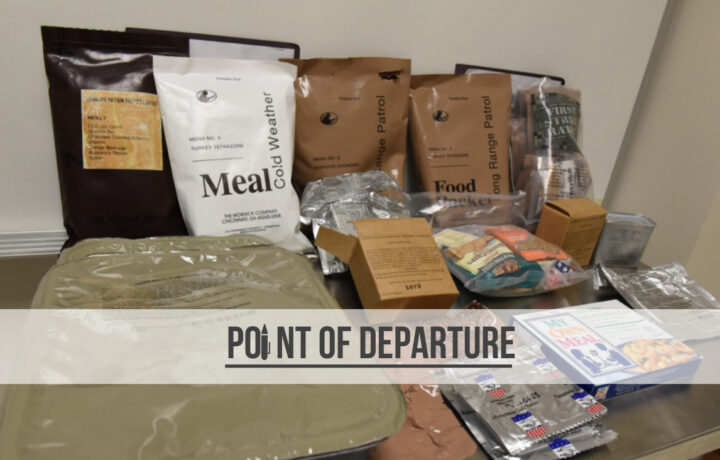It was the unmistakable sound of a gag reflex: subtle, almost imperceptible at first, then just loud enough to recognize it for what it was. I looked up in time to see a student heading for the door, aiming for the restroom just down the hall. I was never the biggest fan of MREs (Meals Ready to Eat), but I’d never had one spur nausea, though a few came close.
I love a good hot dog, but the four fingers of death (Menu 6: Frankfurters, Beef) always caused major bowel distress. Chicken a la king (Menu 9), with the consistency and odor of baby poop, admittedly made me queasy. The old veggie burger (Menu 12) tasted like reconstituted dirt. The cheese and vegetable omelet (Menu 4) was beyond heinous. And the dehydrated beef and pork patties meal (Menu 1) was always left in the box for a reason: you couldn’t shake the idea someone had scraped roadkill off I-20 in the middle of Texas and stuffed it in a pouch.
So, when I decided to conduct an MRE taste-testing with my students recently, I purposely chose meals that (a) were on the newer end of the menu spectrum, and (b) sounded at least somewhat palatable. Then I saw Hannah scurry out the door and knew that some things never change.
The Experiment
Feeding my students is nothing new. I typically bring them cookies, cupcakes, donuts, and even pizza. It sets the environment, allowing for a more engaging setting for both learning and discussion. Think of it as breaking bread, but with 45 people at one time. We eat, we talk, we learn. This time, though, it was going to be a little different.
They had no idea what I was going to bring for class that day. Gourmet donuts from the specialty bakery just off campus? Decadent stuffed cookies from the shop near my house? Pudding balls from the 24-hour bakery that caters to anyone with a sweet tooth at 0300? Nope. I had something special in mind for them.
The rules were simple: break down into case study groups, take an evaluation form, and sample something from whatever I provided. Then I reached into my old aide bag (I forgot just how big that thing was) and began distributing the MREs. Some people were excited. Some were surprised. And some were a little trepidatious.
There were eight meals to sample from that day: chicken and rice bowl (Menu 16); Mexican style rice and bean bowl (Menu 14); pepperoni pizza (Menu 23); cheese tortellini (Menu 13); beef patty, jalapeno pepper jack (Menu 19); pork sausage patty, maple flavored (Menu 17); southwest beef and black beans (Menu 24); and Italian sausage with peppers (Menu 20). All of those sounded better than anything offered during my time in uniform, so I assumed—wrongly, it turned out—that these meals would be met with much more appreciation than in my time.
The students quickly dug in, breaking out the entrées and accessories, setting up MRE heaters, and getting to work. Inevitable questions arose, such as, “Did these come with cigarettes when you were in the Army?” The MRE heaters were a source of universal interest, and one student took it upon himself to start lighting matches. I’ll have to keep an eye on that one in the future.
The task was relatively simple. On a scale of 1 to 5 (with one being a near-nauseating experience), rate the meals on the following: (1) appearance, (2) taste, (3) odor, (4) entrée, (5) accessories, and (6) overall score. When they were finished, I collated the data by meal, rated area, overall rating, and group average by rated area.
The Results
When we wrapped up the experiment, there were clear winners and losers. Southwest beef and black beans (3.93) edged out the Mexican style rice and bean bowl (3.90). Pepperoni pizza (2.17) and the beef patty (2.17) stood side-by-side at the bottom of the pack. The southwest beef and black beans meal was easily the highest rated entrée (4.4), while the maple flavored pork sausage patty was the lowest (1.4). It’s worth noting, however, that the accessories in the sausage patty menu were by far and away the highest rated (4.2).
In the aggregate, the data revealed some interesting trends. While the appearance (2.5) and odor (2.7) of the entrées were generally low, taste (3.3) was better than expected. The accessory items (3.8) always save the day, and the overall rating (3.1) of the meals was probably about right. As I told the students that day, “These usually taste their best when you haven’t slept or eaten for 48 hours.” The most offensive entrée that day was the cheese tortellini; even after being warmed in an MRE heater, it has a relatively disgusting appearance when it’s squeezed from the bag, enough to cause a gag reflex and hasty exit. The most disappointing entrée was the pepperoni pizza, which was coated in congealed grease and sounds decidedly better than it tastes (1.7). The pork sausage patty looked (2.6) and tasted (2.8) much better than it smelled (1.4), which is good since the odor was beyond awful.
I’m going to repeat this experiment again in the fall with a new group of students, but we’re going to mix it up a bit. In addition to the standard menu, I am including cold weather and humanitarian MREs. That should keep things interesting. And, for a little something special, we’ll have one group test a French ration, which to be completely honest, looks a lot better than anything we pull out of a bag.




